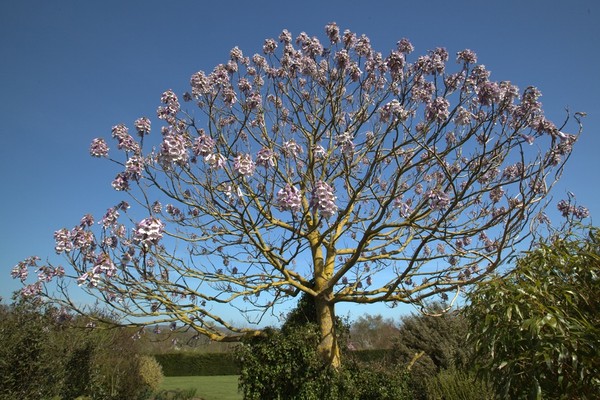
The rediscovery of the Paulownia tree
The Paulownia tree was brought to Europe from the far east in the 1800s, and has since considered a majestic ornamental tree. Recently it has started to be appreciated also for its wood, which is used to produce doors and windows, furniture, and even musical instruments. Also worth mentioning is its role in the wood to energy supply chain
The persisting crisis of market prices of many cereals, which have always been the primary source of revenue for Italian agricultural farms, is behind increasing product diversification. Land-conversion is both to seasonal crops (for instance oil and fibre plants, whose market value is performing better at present) and to high added value crops, such as tree species for the production of wood or biomass, which are mostly multi-annual crops that allow, at least in part, to reduce costs of soil tillage, costs that can also be spread over a longer period of time. Among the species of trees for wood production being considered in this respect, the Paulownia tomentosa is prompting growing attention, because it is suitable for a series of uses, often also complementary (see box).
Soil preparation
The Paulownia has a very low waterlogging tolerance so it must be planted in dry, well drained and deep soil, with less than 25% clay, porosity inferior to 50%; also, the layer of earth it is planted in must be at least 2 m from groundwater reserves or rock walls. Ph must be generally neutral of slightly alkaline, with values between 5.5 and 8, and with low salinity (<1%). Also in relation to the various climate zones, the tree can be cultivated in areas up to 1200 m in altitude, keeping in mind that productivity decreases with the increase of altitude. Planting that uses grafting or root sprouts must be carried out between November and April, while transplant of seedlings must be done from April to August.
As with orchards and poplar groves, virgin soil must be prepared with deep tillage. Land that has already been cultivated may, on the other hand, be ploughed to a depth of 50-60 cm, after which trenching and harrowing of the superficial layers can take place.
An alternative is to till only the portion of soil where the trees will be planted, using an earth drill or cutter tips Ø min 60 cm, at a depth of about 80-100 cm. This solution is preferable for lands subject to erosion (typically sloping terrain), because this technique does not interfere excessively with the superficial structure of the soil, and better wards off superficial leaching.
Grove layout
Tree spacing must be carefully assessed, in relation to the size of the equipment necessary for cultivation (tractors, mowers, sprayers, but also and especially with regard to the intended use of the trees.For timber production the recommended layout is 3x3 m or 4x3 m, in which case a 50% thinning is required during the fourth year, while harvest takes place after eight years from planting, so that another 50% of plants is left to grow. These plants left to grow are in fact already in their fourth year, because they have grown from the stumps left after the thinning. This solution increases productivity, but presents various difficulties in management (during cultivation but especially during harvest) if compared to more spacious layouts, such as the 4x4 m, 5x4 m, and also the 5x5 m, in which case harvest occurs between the eighth and tenth year after planting.
For biomass production (mainly production of wood chips) it is necessary to reduce spacing drastically, because harvest is generally carried out every two or three years. The most advantageous layout has an inter-row space of 2 m, with plants every 50 cm. Before transplant, and especially with virgin soil, it is recommended to carry out a preliminary weeding with non-selective herbicides, to prevent the growth of any plant which may compete with the young trees.
Basal fertilization
As with all poliennial woody crops, physical preparation of the soil must be followed by thorough basal fertilization, better if organic. This will be very useful in the first stages of growth of the plant, because when the tree has reached maturity the abundant foliage of the Paulownia does not impoverish the soil of organic substances, on the contrary, it enriches it.
In any case, the plant’s intake of nitrogen, phosphorous and potassium can be compensated by implementing specific fertilizing programmes, which can be applied using machinery such as the single disk or twin disk broadcaster for synthetic fertilizers, or manure spreader and slurry spreader for organic fertilizers.
Transplant
If the propagation materials are potted seedlings, transplanting is generally carried out manually. The seedlings are carried in their bins to the field by a small tower and put directly in the holes that have been prepared beforehand (on the bottom of which there may be some organic fertilizer). The sides of the holes are then filled with earth, after which about 2 l of water can be applied. To prevent the eventual growth of weeds it is best to cover the soil around the plant with mulch.
Inter-row care / Space between the rows
The Paulownia tree grows in areas where precipitations are between 500 and 3000 mm a year. Optimal growth, which may generate a commercially acceptable production, requires at least 700 mm a year during growing season (late spring and early autumn). In areas lacking precipitations it is necessary to implement an integrative irrigation programme. Also, especially during the first phases of growth, the soil around the trunk of the plant, an area of at least one metre in diameter, must be carefully inspected for infesting weeds.
It is important to provide adequate irrigation especially during the first two years after transplant, and in particular during the first 2-3 months, during which it is necessary to water the seedlings 2-3 times a week for 2-3 hours a day during the hottest months (the quantity of water can be reduced by half in winter and autumn). The water must be distributed in a localized way by using 2 l/h drippers, so as to keep the earth humid to a depth of about 40 cm. However it is also important to not exceed the quantity of water, because the Paulownia tree is very sensitive to waterlogging, which leads to death of the plant due to root asphyxiation. Alternatively, flood irrigation with ad hoc small channels is the most convenient solution in areas where there is no shortage of water.
Pruning
In the case of groves for the production of timber, during the first winter following planting (so during the dormant period) it is necessary to cut the plant just above the soil profile using large shears or a light chain saw. It is advisable to apply mulch on the cut surface, to protect it from external agents. When the temperature goes back up to 12-14°C, shoots will form on the small trunk, which will have to be thinned as they reach a hight of about 50 cm so as to leave only one shoot, which will have an extremely rapid growth.
The small shoots that appear on the new trunk will in turn be eliminated, so that the tree will have branches only starting from 5-6 m in hight. This operation can be carried out with shears of small chain saws, ladders or a forklift truck, to obtain a straight trunk with no knots or defects.
In the case of trees for biomass production, on the other hand, the production of wood must be maximised; shape and size of the plant are not important, so cuts and elimination of branches at the base of the trunk are not necessary. With regard to these aspects cultivation is less costly.
Harvesting
For production of windows and doors, furniture, musical instruments, etc., logging is carried out with traditional chain saws, managing the following stages (delimbing, concentration and transport) the same way they would be managed in any other forest site. If the area is very large (hundreds of hectares) harvest mechanization would profit from dedicated forestry machinery, such as harvesters equipped with processors or processors mounted on earthmoving machines.
If, on the other hand, the material has been cultivated and sold to the wood-energy industry, the machinery needed is similar to that used for other tree species (e.g. poplar); a traditional cut is performed with a chain saw and chipping occurs on site, or, after the tree has been felled, the wood is reduced to chips by a shredder equipped with a specific head.
A multifunctional plant
The Paulownia tomentosa, in Italy also known as “Paulonia”, was brought to Europe by the Dutch East India Company. The tree owes its name to Anna Pavlovna, daughter of the Tzar Paul I. The Paulownia became widespread in Italy in the mid 1800s as an ornamental species. In fact when it reaches full maturity is an imposing plant, characterized by large heart-shaped leaves and by very decorative and fragrant flowers.
For a long time the Paulownia was used merely for its ornamental function, but more recently it has attracted much attention as a species that provides timber, characterized by remarkable lightness, a high degree of flexibility and durability. The first stage in processing yields a white wood that presents hardly any grains, knots or defects. It is furthermore highly resistant to fire, it is repellent and resistant to most xylophage insects, and is generally resistant to parasites and moulds. The wood of the Paulownia has a high water content when first harvested (bulk density is 800 kg/m³, with humidity at 30%), but it can be dried very quickly and naturally in the open, so much that in ideal conditions in about only one month humidity drops to 12-15% and density to 350-400 kg/m³. This material is indicated for the production of interior furnishings, doors and window frames, but also the manufacture furniture, particle boards, wood pulp, etc. Furthermore, thanks to its uniform structure, it can also be used to make musical instruments and more in general objects that require a high degree of precision during processing.
From an environmental point of view it is interesting to note that this tree is very much employed in securing areas subject to landslides, because of its very strong taproot which grows very quickly, while its luxuriant foliage is very suitable for the creation of wind-breaks. The impressive blossoming of the Paulownia species is also very useful in beekeeping, in fact it is possible to obtain up to 1000 kg/ha of savoury honey.
The main peculiarity of this species is however its extremely rapid growth: in good conditions the tree can reach 15 m in hight in only three years. It is, for this reason, a very recommended plant for the production of biomass for energy purposes in short rotation forestry, the only limitation being the high amount of water contained in the young wood soon after harvest. Finally, the leaves can be used to feed animals, while the flowers are not only melliferous, but can also be used for extracting active ingredients.








